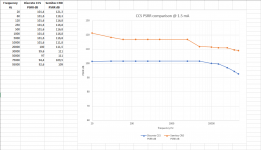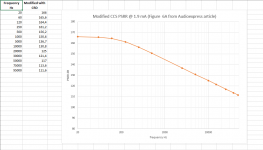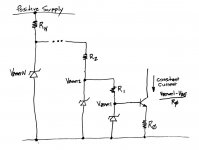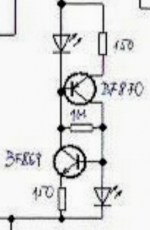It was noted in another thread that ready-made CCS, as current regulator diodes (CRD), are better than discrete ones. I had CCS on breadboard and those diodes laying around, so decided to check. Comparison between “two diode & BJT” CCS vs. Semitech current regulator diode (two terminal JFET CCS) at 1.5 mA current was made.
To my surprise, CRD CCS is better.
Working on some design, you are guaranteed to reinvent the wheel several times at least. I found that similar proposal was mentioned before on this forum (by peufeu I think), but to find that right choice of search phrases or pure luck is needed. As a newcomer, I can only notice that vast knowledge is buried inside countless threads, waiting to be discovered again.
I won’t discuss other smart and much better CCS designs that can be found here, but simple two diode CCS as found in the article (Figure 4A):
https://audioxpress.com/assets/upload/files/Sources_101_P1.pdf
Replacing resistor R1 with simple CRD, decreases Q1 Vbe modulation by supply ripple and brings + 30 dB improvement in the PSRR of CCS. This is interesting because existing CCS can be upgraded by simple one component exchange.
Edit: some find thread title offensive. I’m always for some humor as we are not discussing life and death matters. So, I’ve made some edits and requested title change.
To my surprise, CRD CCS is better.
Working on some design, you are guaranteed to reinvent the wheel several times at least. I found that similar proposal was mentioned before on this forum (by peufeu I think), but to find that right choice of search phrases or pure luck is needed. As a newcomer, I can only notice that vast knowledge is buried inside countless threads, waiting to be discovered again.
I won’t discuss other smart and much better CCS designs that can be found here, but simple two diode CCS as found in the article (Figure 4A):
https://audioxpress.com/assets/upload/files/Sources_101_P1.pdf
Replacing resistor R1 with simple CRD, decreases Q1 Vbe modulation by supply ripple and brings + 30 dB improvement in the PSRR of CCS. This is interesting because existing CCS can be upgraded by simple one component exchange.
Edit: some find thread title offensive. I’m always for some humor as we are not discussing life and death matters. So, I’ve made some edits and requested title change.
Attachments
Last edited:
If constant current diodes are available only for low voltages a cascode can extend their voltage range.
Have you checked whether a cascoded constant current diode works for high voltages with a similar performance?
P.S.
These are not diodes but a JFET and a resistor with the gate connected to the end of the resistor. This configuration forces the JFET to pass a constant current. They are not diodes but integrated current sources based on JFETS.
The argument for using this type of "diode" instead of a discrete constant current source can be used for anything discrete which has an integrated similar.
Have you checked whether a cascoded constant current diode works for high voltages with a similar performance?
P.S.
These are not diodes but a JFET and a resistor with the gate connected to the end of the resistor. This configuration forces the JFET to pass a constant current. They are not diodes but integrated current sources based on JFETS.
The argument for using this type of "diode" instead of a discrete constant current source can be used for anything discrete which has an integrated similar.
Last edited:
Semitec CRDs are 100 V parts and they are fairly cheap (1 €). It is possible to connect several in series or use Zener diodes in series (Zener is recommended by Semitec).
I can’t check past 35 V voltage as this is limit of my custom-built signal injector. But, I’m sure that several diodes in series connection will have the same performance.
As for the two diodes & BJT CCS, recommended upgrade diode would be E-501 which has perfectly flat UI characteristic.
It is also worth to mention that this CCS has PSRR decrease with higher current. At 15 mA, without modification PSSR falls to 81 dB. But, with CRD as biasing resistor replacement, + 30 dB improvement is still there.
I can’t check past 35 V voltage as this is limit of my custom-built signal injector. But, I’m sure that several diodes in series connection will have the same performance.
As for the two diodes & BJT CCS, recommended upgrade diode would be E-501 which has perfectly flat UI characteristic.
It is also worth to mention that this CCS has PSRR decrease with higher current. At 15 mA, without modification PSSR falls to 81 dB. But, with CRD as biasing resistor replacement, + 30 dB improvement is still there.
Attachments
P.S.
These are not diodes but a JFET and a resistor with the gate connected to the end of the resistor.
Yes, I understand what they are. They are called officially “Current regulator diode” by Semitec.
They are integrated two terminal CCS with great performance and affordable price and that is what matters.
They are standard electronic components known also as Current limiting diodes, although they are not diodes at all. Available in hundredths of different models, but usually very expensive (5 -25 € a piece). Semitech has very reasonable price and very good performance.
I do not know of concrete examples where they are used in amplifiers, but have no doubt that they are used in some.
I do not advocate that all discrete CCS should be replaced with CRD or IC CCS types. I’m just pointing that they have very good performance and can be used in some applications instead of discrete CCS.
And, they make terrific upgrade to standard discrete CCS.
I do not know of concrete examples where they are used in amplifiers, but have no doubt that they are used in some.
I do not advocate that all discrete CCS should be replaced with CRD or IC CCS types. I’m just pointing that they have very good performance and can be used in some applications instead of discrete CCS.
And, they make terrific upgrade to standard discrete CCS.
they make terrific upgrade to standard discrete CCS.
This is simply not right, in other words pure nonsense.
Personally I would never used that thing and his brother in an amplifier or preamp.
I have seen something simmilar been used in a discrete Opamp. Not my style.
A discrete BJT CCS is a lot better
You got it wrong. 🙂
It is meant as upgrade to discrete CCS that brings 30 dB PSRR increase (biasing resistor replacement), as outlined in the first post.
It is meant as upgrade to discrete CCS that brings 30 dB PSRR increase (biasing resistor replacement), as outlined in the first post.
Considering the minimum working voltage of CRD normally over 0.8v, it may not be in-place for 2 diodes/BJT CCS.
Huh, do we have another misunderstanding?
It is not idea to replace ordinary diodes with CRD. Biasing resistor R1 that provides current through diodes is replaced by CRD. Check Figure 4A from the Audioexpress article.
It is not idea to replace ordinary diodes with CRD. Biasing resistor R1 that provides current through diodes is replaced by CRD. Check Figure 4A from the Audioexpress article.
I have been using Semitec's CRDs in production for at least 25 years, and find them a very convenient tool (pity that the J505 / J511 series popularized by Siliconix are no longer made).
Semitec's CRDs are not all 100V. Up to 5.6mA they are 100V; 8.2mA / 10mA / 12mA are 30V, while 15mA / 18mA are 25V.
Also, the low-value parts have a fairly flat relationship between current vs. voltage curve, but the higher the value, the more there is a distinct curve. Current fluctuations can be minimized by setting the voltage across the CRD for the peak of the curve
But there are also self-heating effects (current value will decrease slightly as the CRD heats up over time), therefore even though both glass-encapsulated leaded versions (E-series) and space-saving SMD versions (S series) are available, packing them tightly on a PCB may not result in the most consistent current.
As always, in addition to reading the data sheet carefully, measure the parts for yourself so that you understand their strengths and weaknesses.
Leaded types
E Series (Axial Lead Type) – SEMITEC Corporation
SMD types
S Series (SMD Type) – SEMITEC Corporation
Semitec Current Regulator Diodes – Mouser
kind regards, jonathan
Semitec's CRDs are not all 100V. Up to 5.6mA they are 100V; 8.2mA / 10mA / 12mA are 30V, while 15mA / 18mA are 25V.
Also, the low-value parts have a fairly flat relationship between current vs. voltage curve, but the higher the value, the more there is a distinct curve. Current fluctuations can be minimized by setting the voltage across the CRD for the peak of the curve
But there are also self-heating effects (current value will decrease slightly as the CRD heats up over time), therefore even though both glass-encapsulated leaded versions (E-series) and space-saving SMD versions (S series) are available, packing them tightly on a PCB may not result in the most consistent current.
As always, in addition to reading the data sheet carefully, measure the parts for yourself so that you understand their strengths and weaknesses.
Leaded types
E Series (Axial Lead Type) – SEMITEC Corporation
SMD types
S Series (SMD Type) – SEMITEC Corporation
Semitec Current Regulator Diodes – Mouser
kind regards, jonathan
Last edited:
Huh, do we have another misunderstanding?
It is not idea to replace ordinary diodes with CRD. Biasing resistor R1 that provides current through diodes is replaced by CRD. Check Figure 4A from the Audioexpress article.
That makes more sense.
I generally try to use depletion mode mosfet current sources. BSS159 is one of my favorites, though they come in all sorts of current and voltage ratings up to 1000V.
In my amplifier the input stage uses a constant current source which delivers 2.9mA. This means, in my case, I would need one supplying a constant current of 2.9mA. A cascode protecting the constant current source pseudo-diode should protect it from high voltage. As accentuated previously, heat generation in these devices, causes them to drift.
Nevertheless, this is good news, as I can use the constant current source high voltage transistor as a cascode with the emitter resistor replaced with the appropriate constant current diode.
This is another option, which is good, and improving the PSRR, is a mouth watering prospect worthy of investigating.
Nevertheless, this is good news, as I can use the constant current source high voltage transistor as a cascode with the emitter resistor replaced with the appropriate constant current diode.
This is another option, which is good, and improving the PSRR, is a mouth watering prospect worthy of investigating.
Four element CCS with up to 160 dB PSRR
Checking better performing CCS from the referenced Audioexpress article (FIGURE 6A), it is confirmed that using humble CRD brings significant improvement. I used TL431 voltage reference as that was in my drawers. There are better voltage references and using more expensive CRD, that maintains its performance at high frequency, will result in even better performance or less falling at high frequency.
My conclusion is that, if discrete CCS contains biasing resistor in any form, replacing it with CRD brings substantial PSSR performance increase.
Checking better performing CCS from the referenced Audioexpress article (FIGURE 6A), it is confirmed that using humble CRD brings significant improvement. I used TL431 voltage reference as that was in my drawers. There are better voltage references and using more expensive CRD, that maintains its performance at high frequency, will result in even better performance or less falling at high frequency.
My conclusion is that, if discrete CCS contains biasing resistor in any form, replacing it with CRD brings substantial PSSR performance increase.
Attachments
An old trick played by John Curl, in the circuit design of the Mark Levinson ML-1 power amp, still works well today: Use zener diods to pre-regulate the voltage applied to the housekeeping portions of a constant current source. Now the bias resistor has Vzener2 on its upper terminal and Vzener1 on its lower terminal. Voila! Constant voltage across the resistor means constant current through the resistor. And you can cascade these, as many times as you wish, for even greater PSRR.
Another bonus: Zener diodes are more numerous, and more inexpensive, than CRDs or JFETs or depletion MOSFETs.
_
Another bonus: Zener diodes are more numerous, and more inexpensive, than CRDs or JFETs or depletion MOSFETs.
_
Attachments
An old trick played by John Curl, in the circuit design of the Mark Levinson ML-1 power amp, still works well today: Use zener diods to pre-regulate the voltage applied to the housekeeping portions of a constant current source. Now the bias resistor has Vzener2 on its upper terminal and Vzener1 on its lower terminal. Voila! Constant voltage across the resistor means constant current through the resistor. And you can cascade these, as many times as you wish, for even greater PSRR.
Another bonus: Zener diodes are more numerous, and more inexpensive, than CRDs or JFETs or depletion MOSFETs.
_
How's that track with temperature? Vz1 could have a negative temp coeff while Vz2 has a positive. If the zeners are different voltage they will have different temp coeffs. Wont change PSRR but your bias will drift with temp.
Last edited:
Current source and current sink interconnected in a way that each serves as others biasing source, decreasing voltage reference (LEDs) modulation and with 1 M resistor as negative feedback working on both source and sink. It is better than single LED + BJT CCS that has about 105 dB PSRR at 2 mA.
I think that, at 2 mA, this CCS wouldn’t go past 120 - 130 dB PSRR, and at actual current has about 100 to 110 dB PSRR.
I think that, at 2 mA, this CCS wouldn’t go past 120 - 130 dB PSRR, and at actual current has about 100 to 110 dB PSRR.
- Home
- Amplifiers
- Solid State
- Improving simple CCS PSRR by 30 dB




